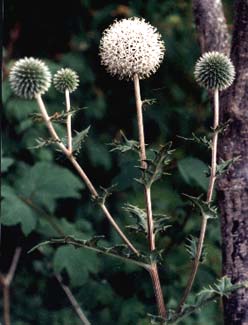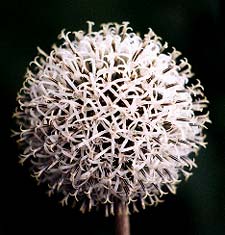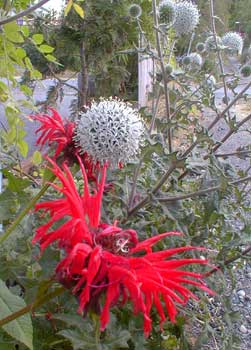
'Arctic Glow'
Globe Thistle
"When on the breath of autumn breeze,
From pastures dry and brown,
Goes floating like an idle thought
The fair white thistle-down."
-Mary Howit
(1799-1888)
(1799-1888)
Echinops sphaerocephalus 'Arctic Glow' is easily grown in full sunlight in well-draining moderatly moist soils, & becomes drought tolerant once it has deeply set its taproot. It also tolerates poor soils & is even a little averse to too fertile a medium. The first two photos show it in August (2003).
 Once it is well-rooted it can't be transplanted with much chance of success, as the taproof will become damaged, so locate it carefully. Ours is in a relatively low-maintance alleyway where it's competition for space is mainly bee-balm (the third photo shot in July 2004 shows the thistle's flower along with a nearby
'Jacob Kline' Bee Balm). The bee-balms & the thistles are equally agressive about taking over their location, so are good partners. There are also both very attractive to bees, bee-flies, butterflies & all sorts of pollinating insects. There are invariably bees on the thistle flowers, & butterflies not far off.
Once it is well-rooted it can't be transplanted with much chance of success, as the taproof will become damaged, so locate it carefully. Ours is in a relatively low-maintance alleyway where it's competition for space is mainly bee-balm (the third photo shot in July 2004 shows the thistle's flower along with a nearby
'Jacob Kline' Bee Balm). The bee-balms & the thistles are equally agressive about taking over their location, so are good partners. There are also both very attractive to bees, bee-flies, butterflies & all sorts of pollinating insects. There are invariably bees on the thistle flowers, & butterflies not far off.It's a strongly upright perennial with hard stickery silver-green leaves & red stems, easily reaching three feet tall, often to four feet. Each of the spiny leaves, with white fuzz on the undersides, grow to a foot length or longer, so that the overall spread of a single thistle is commonly two feet & often three feet wide.
 The cultivar 'Arctic Glow' is a bit more compact than the species. If grown in too much shade or too rich a soil, the taller stems will be weak from too rapid a growth & could require staking, but will otherwise do well; in fuller sunlight & poorer soil, it will be sturdier & shouldn't need staking.
The cultivar 'Arctic Glow' is a bit more compact than the species. If grown in too much shade or too rich a soil, the taller stems will be weak from too rapid a growth & could require staking, but will otherwise do well; in fuller sunlight & poorer soil, it will be sturdier & shouldn't need staking.Native of Europe & western Asia, it's normal bloom period is July & August, but can frequently be extended to first frost by religious deadheading.
The large perfectly round white flowers atop tough red stems almost look like ornately pierced & carved ivory balls. About half of the ivory balls are two inches wide, the other half a solid three inches.
These blooms make quite a unique impact in the garden, are gorgeous as cut flowers, & are also easily prepared as dried flowers.
Deadheading is essential to extend the bloom period, & to keep the thistle from achieving a rangier height, as well as to keep the blossoms from self-seeding. It naturalizes rather too easily, & the sharp leaves might not be pleasantly received if they start springing up in self-selected locations.
In autumn it will begin to die back & become rather unpleasant, & should be lopped off near the ground & sent to the compost pile. It'll return stronger than ever the following spring.